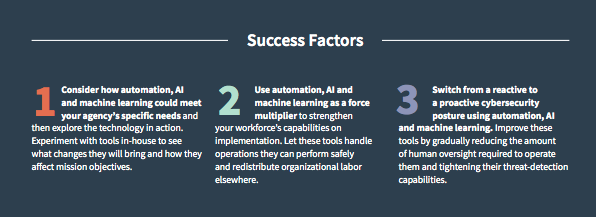This article is an excerpt from GovLoop’s recent report titled “Your Guide to Key Advancements in Government Cybersecurity.” Download the full report here.
Emerging technologies such as automation, artificial intelligence and machine learning have the potential to reshape entire fields — and government cybersecurity is no exception.
These three capabilities are often intertwined, with automation enabling agencies to perform actions with limited or no human intervention. Machine learning assists computers by using data to exponentially improve their results on a task, and AI allows machines to imitate functions humans classify as cognitive.
The federal government has taken notice, and the Trump administration has prioritized funding for foundational AI research, plus autonomous systems, computing infrastructure and machine learning. Trump’s fiscal 2019 budget request made him the first president in history to list AI, autonomous and unmanned systems as administration research and development priorities.
“Artificial intelligence holds tremendous potential as a tool to empower the American worker, drive growth in American industry and improve the lives of the American people,” Michael Kratsios, Deputy Assistant to the President and Deputy U.S. Chief Technology Officer, said May 10 at the White House’s Artificial Intelligence for American Industry Summit. “Our free market approach to scientific discovery harnesses the combined strengths of government, industry and academia, and uniquely positions us to leverage this technology for the betterment of our great nation.”
Automation, AI and machine learning are increasingly important to the federal government’s cybersecurity infrastructure, and state and local governments are following suit. All three capabilities accelerate the speed at which cyberthreats are addressed, while reducing cost and overall human involvement.
An October 2017 ServiceNow survey found that 39 percent of federal decisionmakers identified intelligent automation as very beneficial to resolving security threats.
There are concerns that automating processes could have a negative impact and complicate an organization’s cybersecurity, however, because the technology also gives hackers a new attack tool. Government applications for automation, AI and machine learning keep evolving, but some federal, state and local agencies are already reaping huge cybersecurity benefits from using these technologies.
Improving Cybersecurity in Las Vegas
Las Vegas’s government is using advanced machine learning technology to ward off threats to the city’s private, sensitive data.
The technology platform, known as the Enterprise Immune System, uses AI algorithms and unsupervised machine learning to help safeguard Las Vegas’s cybersecurity, which is no small feat because of the city’s size. Las Vegas has more than 640,000 residents, an online network of 3,000 users and an annual influx of more than 42 million tourists. CIO Michael Sherwood said shielding such a large amount of data is difficult given these statistics.
“The threat landscape here is always evolving,” he said. “You only have so much [of what] we’ll call ‘brain capital’ in your organization. Mathematically, I don’t think you can hire your way out of cybersecurity. You need supplements. You have to trust in technology.”
Darktrace, the company behind the Enterprise Immune System, calls it a “self-learning cyber defense technology that begins to understand a ‘pattern of life’ for a network as soon as it is installed.” The system plots an “understanding of normality” for an environment’s individual users, devices and networks, helping it recognize unusual activity and potential dangers afterward.
Las Vegas uses the tool to automatically take measured action against potential threats without human involvement, such as halting a download from a banned filesharing program. The city can also see a 3D representation of its cyber environment, letting government officials visualize external and internal dangers in real time.
“These technology tools are helping me allocate more resources more appropriately,” Sherwood said. “I can take the labor savings and move that to other areas and make the organization more efficient. It’s critical to the operation.”
AI and machine learning programs such as Darktrace’s allow cybersecurity teams to do more with less by reducing human involvement.
Las Vegas is not the only government using this technology. Others include Scotland; Livingston County, Michigan; Auburn, Washington; and Australia’s Lockyer Valley Regional Council. “Ensuring the security and functionality of a network that serves 80,000 citizens and protecting sensitive financial data on the city’s multimillion[-dollar] budget, is a task too great for a single security officer,” said Paul Haugan, Auburn’s Director of Innovation and Technology. “After deploying the Enterprise Immune System, it’s like we have a 24/7 security team.” “The AI alerts us to threats we would never have known about,” Haugan added. “For us, deploying Darktrace wasn’t an option; it was a necessity in staying ahead of today’s advanced and unpredictable threats.”
Cybersecurity is an ever-shifting landscape, but AI and machine learning can help governments of all shapes and sizes.






It’s cool but a little scary to imagine AI being responsible for security–I certainly hope the people developing these technologies know what they’re doing, or are at least familiar with the important issues raised by I, Robot.